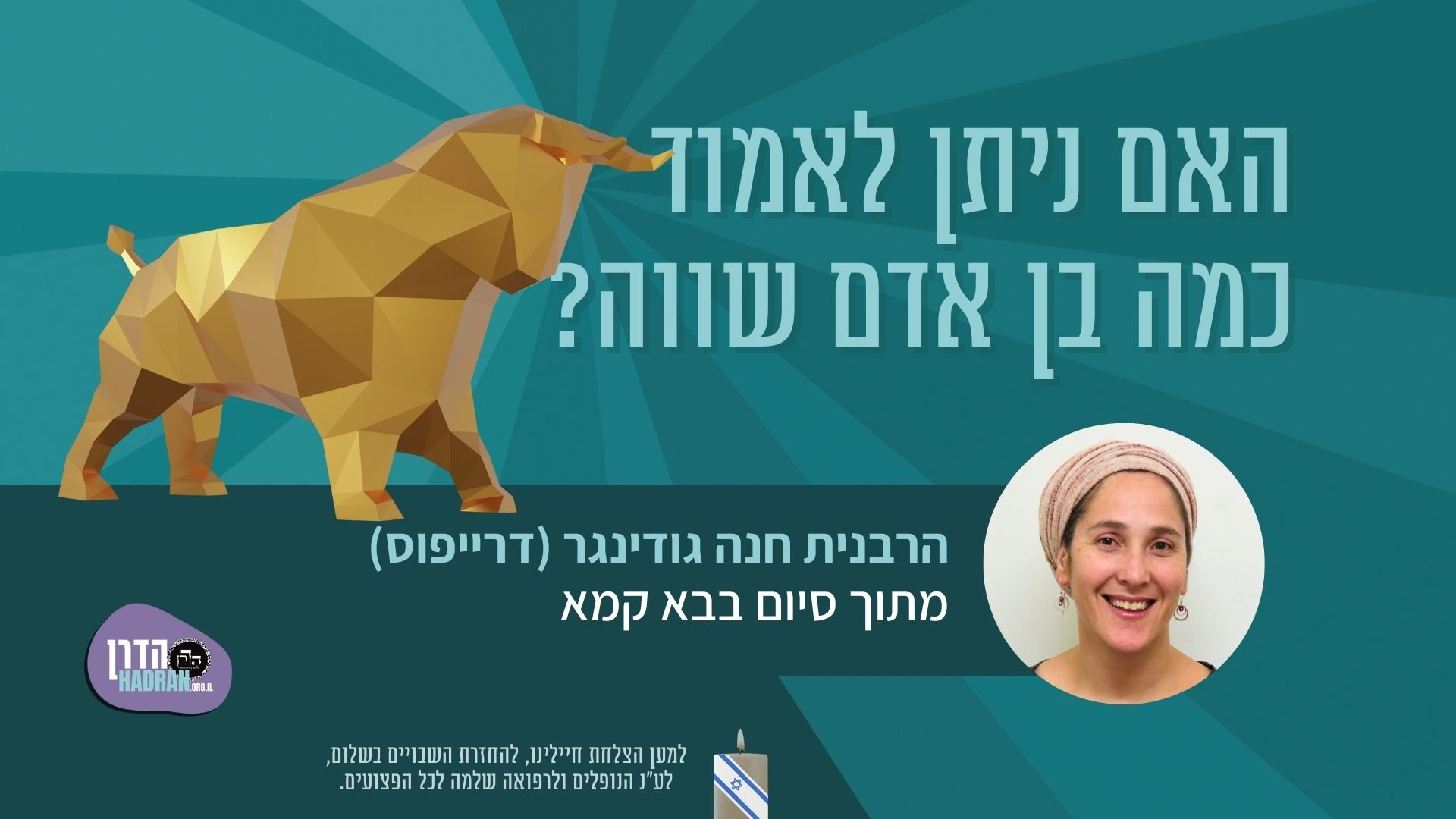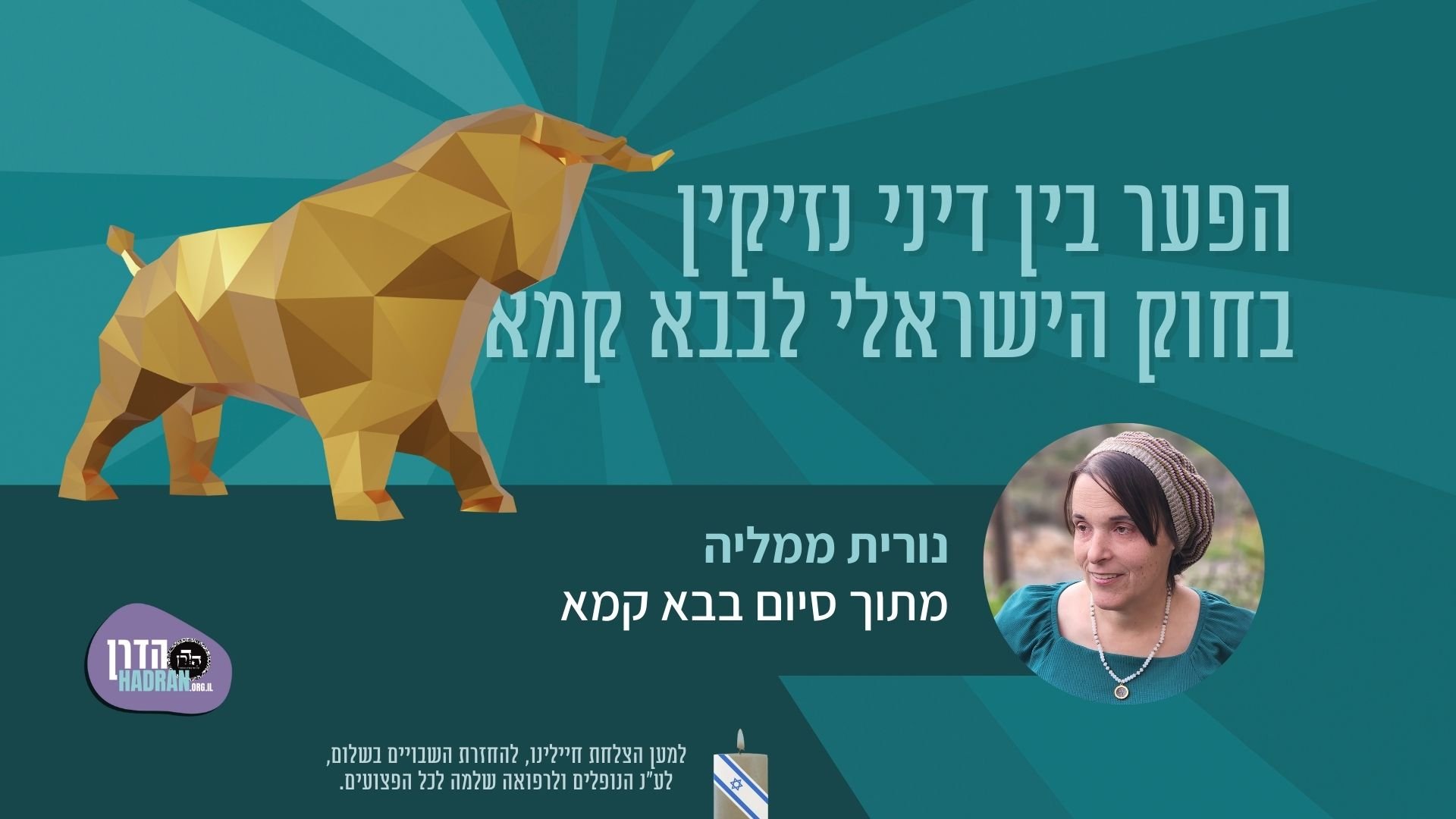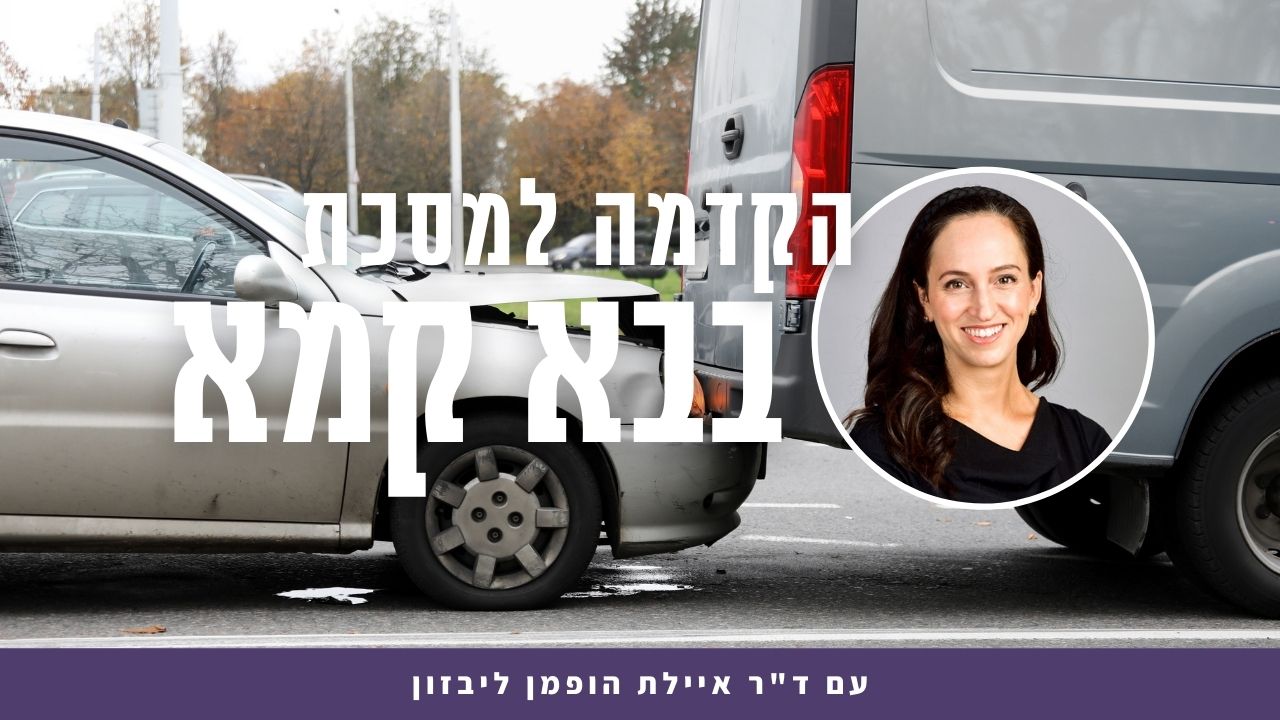בבא קמא ו
לְאֵתוֹיֵי לִיחֲכָה נִירוֹ וְסִכְסְכָה אֲבָנָיו.
The Gemara answers: It serves to add cases where the fire scorched another’s plowed field and cases in which it singed his stones. Even though the damaged object remains intact and is not consumed by the fire, one is still liable to pay for the damage caused.
הַצַּד הַשָּׁוֶה שֶׁבָּהֶן. לְאֵתוֹיֵי מַאי? אָמַר אַבָּיֵי: לְאֵתוֹיֵי אַבְנוֹ סַכִּינוֹ וּמַשָּׂאוֹ שֶׁהִנִּיחָן בְּרֹאשׁ גַּגּוֹ, וְנָפְלוּ בְּרוּחַ מְצוּיָה וְהִזִּיקוּ.
§ The mishna teaches: The common denominator of the components in all these categories is that it is their typical manner to cause damage. The Gemara asks: In order to add what halakha is this statement cited in the mishna? Abaye said: The stating of the common denominator in the mishna serves to add that one is liable in a case of his stone, his knife, or his load, where he placed them on top of his roof, and they fell off the roof by means of a common wind and caused damage.
הֵיכִי דָּמֵי? אִי בַּהֲדֵי דְּקָא אָזְלִי קָא מַזְּקִי – הַיְינוּ אֵשׁ!
The Gemara asks: What are the circumstances in which one would be liable for the damage that was caused? If it is a case where those items cause damage as they are moving through the air propelled by the wind, that is a subcategory of Fire.
מַאי שְׁנָא אֵשׁ – דְּכֹחַ אַחֵר מְעוֹרָב בּוֹ, וּמָמוֹנְךָ וּשְׁמִירָתוֹ עָלֶיךָ; הָנֵי נָמֵי, כֹּחַ אַחֵר מְעוֹרָב בָּהֶן, וּמָמוֹנְךָ וּשְׁמִירָתוֹ עָלֶיךָ!
Therefore, one could claim: If so, what is different about Fire that defines it as a unique category? It is that another force is involved with it in causing damage, as it is the wind that causes the fire to spread and cause damage; and the entity propelled by the wind is your property, and responsibility for its safeguarding, to prevent it from causing damage, is incumbent upon you. In these cases, too, another force is involved with them in causing damage; and the objects are your property, and responsibility for their safeguarding, to prevent them from causing damage, is incumbent upon you. Perforce, there is no need for the common denominator in the mishna to teach the case of an object that causes damage when propelled off a roof by the wind. That case is included in the primary category of Fire that is explicitly mentioned in the mishna.
וְאֶלָּא בָּתַר דְּנָיְיחִי. אִי דְּאַפְקְרִינְהוּ – בֵּין לְרַב בֵּין לִשְׁמוּאֵל, הַיְינוּ בּוֹר!
Rather, perhaps the common denominator serves to teach the halakha that one is liable when after those objects fall from the roof they come to rest on the ground, and they cause damage as an obstacle on which a person or an animal stumbles. The mishna teaches that the one who placed them on the roof is liable. The Gemara questions this explanation: What are the circumstances in which one is liable? If it is a case where one declared them ownerless, both according to Rav and according to Shmuel, this is a subcategory of Pit.
מַאי שְׁנָא בּוֹר – שֶׁכֵּן תְּחִילַּת עֲשִׂיָּיתוֹ לְנֵזֶק, וּמָמוֹנְךָ וּשְׁמִירָתָן עָלֶיךָ; הָנֵי נָמֵי, תְּחִילַּת עֲשִׂיָּיתָן לְנֵזֶק, וּמָמוֹנְךָ וּשְׁמִירָתָן עָלֶיךָ!
Therefore, one could claim: What is different about Pit that defines it as a unique category? It is that its initial formation, i.e., the digging of the pit, is done in a manner that can result in damage, and it is your property, and responsibility for its safeguarding, to prevent it from causing damage to others, is incumbent upon you. With regard to these items he had placed on the roof, too, their initial formation, i.e., when they are placed in the public domain, is done in a manner that can result in damage, and they are your property, and responsibility for their safeguarding, to prevent them from causing damage, is incumbent upon you. Perforce, there is no need for the common denominator in the mishna to teach the case where the objects fell from the roof, came to rest in the public domain, and were declared ownerless. That case is included in the primary category of Pit that is explicitly mentioned in the mishna.
אֶלָּא דְּלָא אַפְקְרִינְהוּ? לִשְׁמוּאֵל, דְּאָמַר: כּוּלָּם מִבּוֹרוֹ לָמַדְנוּ, הַיְינוּ בּוֹר!
Rather, perhaps the common denominator serves to teach the halakha that one is liable even in a case where one did not declare them ownerless. The Gemara asks: According to Shmuel, who says: We learned that one is liable to pay for damage caused by all obstacles that one places in a public domain, whether or not he declares them ownerless, from the halakhot with regard to one’s pit; this is a subcategory of Pit. The question remains: What halakha does the common denominator in the mishna teach?
לְעוֹלָם דְּאַפְקְרִינְהוּ; וְלָא דָּמוּ לְבוֹר, מָה לְבוֹר – שֶׁכֵּן אֵין כֹּחַ אַחֵר מְעוֹרָב בּוֹ; תֹּאמַר בְּהָנֵי, שֶׁכֹּחַ אַחֵר מְעוֹרָב בָּהֶן.
The Gemara answers: Actually, the mishna teaches one’s liability in a case where one declared the objects ownerless, and even if he declared them ownerless, those objects are not similar to the primary category of Pit. What is notable about the primary category of Pit? It is notable in that there is no other force involved with it in causing the damage. Will you say the same with regard to these cases, where there is another force involved with it in causing the damage, i.e., the wind that propelled them from the roof to rest on the ground?
אֵשׁ תּוֹכִיחַ!
The Gemara suggests: If one attempts to challenge the derivation from Pit in this manner, it is possible to respond: The halakha of the primary category of Fire will prove that this factor, that there is another force involved with the object in causing the damage, is not a reason to exempt one from paying restitution for the damage, as although there is another force involved in the spreading of a fire, one is liable for the damage the fire causes, so the halakha with regard to these objects can be derived from that of Fire.
מָה לְאֵשׁ – שֶׁכֵּן דַּרְכּוֹ לֵילֵךְ וּלְהַזִּיק.
The Gemara questions the derivation from Fire: What is notable about Fire? It is notable in that its typical manner is to proceed from one place to another and cause damage. Will you say the same with regard to these objects propelled by the wind into the public domain, where it is not their typical manner to proceed and cause damage? Accordingly, how can one learn the halakha in this case from that of Fire?
בּוֹר תּוֹכִיחַ! וְחָזַר הַדִּין.
The Gemara suggests: If one attempts to challenge the derivation from Fire in this manner, it is possible to respond: The halakha of the primary category of Pit will prove that the lack of this characteristic, of a typical manner being to proceed and cause damage, is not a reason to exempt the owner of the objects from paying restitution for the damage, as that is the nature of Pit, and one is liable for damage caused by his pit. The Gemara notes: And as Pit and Fire each prove that the defining characteristic of the other is not decisive in establishing liability or exemption, the derivation has reverted to its starting point, and liability in these cases is derived from the common denominator of Pit and Fire. This is the halakha added by the common denominator stated in the mishna.
רָבָא אָמַר: לְאֵתוֹיֵי בּוֹר הַמִּתְגַּלְגֵּל בְּרַגְלֵי אָדָם וּבְרַגְלֵי בְּהֵמָה.
Rava said: The stating of the common denominator in the mishna serves to add the halakha that one is liable in a case of Pit where an object is rolled by the feet of a person or the hooves of an animal. This is a case where one placed an obstacle in a public domain and the obstacle caused no damage where it was placed, but subsequently was kicked by passersby to a different location where it caused damage.
הֵיכִי דָּמֵי? אִי דְּאַפְקְרִינְהוּ – בֵּין לְרַב בֵּין לִשְׁמוּאֵל, הַיְינוּ בּוֹר;
The Gemara asks: What are the circumstances in which one is liable for damage in that case? If it is a case where one declared the objects ownerless, both according to Rav and according to Shmuel this is a subcategory of Pit.
מַאי שְׁנָא בּוֹר – שֶׁכֵּן תְּחִילַּת עֲשִׂיָּיתוֹ לְנֵזֶק, וּשְׁמִירָתוֹ עָלֶיךָ; הָנֵי נָמֵי – תְּחִילַּת עֲשִׂיָּיתָן לְנֵזֶק, וּשְׁמִירָתָן עָלֶיךָ!
Therefore, one could claim: What is different about Pit that it is defined as a unique category? It is that its initial formation, i.e., the digging of the pit, is done in a manner that can result in damage, and responsibility for its safeguarding, to prevent it from causing damage to others, is incumbent upon you. With regard to these objects, too, their initial formation, i.e., when the obstacle reaches the in the public domain, is done in a manner that can result in damage, and responsibility for their safeguarding, to prevent them from causing damage, is incumbent upon you. Perforce, there is no need for the mishna to state their common denominator to teach the halakha in the case where the objects came to rest and are declared ownerless. That case is included in the primary category of Pit that is explicitly mentioned in the mishna.
אֶלָּא דְּלָא אַפְקְרִינְהוּ? לִשְׁמוּאֵל, דְּאָמַר כּוּלָּם מִבּוֹרוֹ לָמַדְנוּ – הַיְינוּ בּוֹר!
Rather, perhaps the common denominator serves to teach the halakha that one is liable even in a case where one did not declare the objects ownerless. The Gemara asks: According to Shmuel, who says: We learned that one is liable for damage caused by all obstacles that one places in a public domain, whether or not he declares them ownerless, from the halakhot with regard to one’s pit, this is a subcategory of Pit. What halakha does the common denominator in the mishna teach?
לְעוֹלָם דְּאַפְקְרִינְהוּ; וְלָא דָּמֵי לְבוֹר – מָה לְבוֹר, שֶׁכֵּן מַעֲשָׂיו גָּרְמוּ לוֹ; תֹּאמַר בְּהָנֵי, שֶׁאֵין מַעֲשָׂיו גָּרְמוּ לוֹ.
The Gemara answers: Actually, the mishna teaches one’s liability in a case where one declared the objects ownerless, and even if he declared them ownerless, those objects are not similar to the primary category of Pit. What is notable about the primary category of Pit? It is notable in that one’s actions, the digging of the pit, cause the damage. Will you say the same with regard to these cases, where one’s actions do not cause damage? Rather, it is the feet of the passersby that caused the damage, by rolling the object to a different location where it caused damage.
שׁוֹר יוֹכִיחַ!
The Gemara suggests: If one attempts to challenge the derivation from Pit in this manner, it is possible to respond: The halakha of the primary category of Ox will prove that this fact, that one’s actions do not cause the damage, is not a reason to exempt one from paying restitution for the damage, as although the owner’s actions do not cause the ox to cause damage, one is liable for the damage caused by his ox.
מָה לְשׁוֹר, שֶׁכֵּן דַּרְכּוֹ לֵילֵךְ וּלְהַזִּיק. בּוֹר תּוֹכִיחַ!
The Gemara questions the derivation from Ox: What is notable about Ox? It is notable in that it is the typical manner of the animals in these categories to proceed from one place to another and cause damage. By contrast, in the case of the obstacle kicked by passersby to a different location where it caused damage, it is not its typical manner to proceed and cause damage. Accordingly, how can one learn the halakha in this case from the primary category of Ox? The Gemara suggests: The primary category of Pit will prove that this fact, that the typical manner of a category’s components is not to proceed and cause damage, is not a reason to exempt one from paying restitution for the damage, as that is the nature of Pit, and one is liable for damage caused by his pit.
וְחָזַר הַדִּין, לֹא רְאִי זֶה כִרְאִי זֶה.
The Gemara notes: And as Pit and Ox each proves that the defining characteristic of the other is not decisive in establishing one’s liability or exemption, the derivation has reverted to its starting point, which is that the defining characteristic of this primary category of Ox is not similar to the defining characteristic of that category of Pit, and liability in these cases is derived from the common denominator of Pit and Ox. This is the halakha added by the common denominator stated in the mishna.
רַב אַדָּא בַּר אַהֲבָה אָמַר, לְאֵתוֹיֵי הָא דְּתַנְיָא: כׇּל אֵלּוּ שֶׁאָמְרוּ פּוֹתְקִין בִּיבוֹתֵיהֶן וְגוֹרְפִין מְעָרוֹתֵיהֶן; בִּימוֹת הַחַמָּה – אֵין לָהֶם רְשׁוּת, בִּימוֹת הַגְּשָׁמִים – יֵשׁ לָהֶם רְשׁוּת. אַף עַל פִּי שֶׁבִּרְשׁוּת, אִם הִזִּיקוּ – חַיָּיבִים לְשַׁלֵּם.
Rav Adda bar Ahava said: The stating of the common denominator in the mishna serves to add the halakha that one is liable to pay damages in this case that is taught in a baraita: With regard to all those people who engage in activities that the Sages stated are permitted, i.e., those who open their gutters and drain the sewage from their houses into the public domain, and those who flush out the water from their caves, where foul-smelling water was stored, into the public domain, during the summer they do not have permission to do so, while during the rainy season they have permission to do so, since the street is rained upon in any event and thereby washed. And although all these people perform their actions with permission, if they cause damage they are liable to pay for it.
הֵיכִי דָּמֵי? אִי בַּהֲדֵי דְּקָאָזְלִי מַזְּקִי, כֹּחוֹ הוּא!
The Gemara asks: What are the circumstances in which one is liable for damage caused by the sewage? If the sewage causes damage as it is moving, after he poured it into the public domain, it is damage caused by his own direct action, and it is no different from any other damage caused by a person. According to Rav, it is under the rubric of Maveh in the mishna. According to Shmuel it appears in the next mishna, and it is not derived from the common denominator mentioned in the mishna.
אֶלָּא בָּתַר דְּנָיַיח. הֵיכִי דָּמֵי? אִי דְּאַפְקְרִינְהוּ – בֵּין לְרַב בֵּין לִשְׁמוּאֵל הַיְינוּ בּוֹר; מַאי שְׁנָא בּוֹר – דִּתְחִילַּת עֲשִׂיָּיתוֹ לְנֵזֶק, וּמָמוֹנְךָ וּשְׁמִירָתוֹ עָלֶיךָ; הָנֵי נָמֵי – תְּחִילַּת עֲשִׂיָּיתָן לְנֵזֶק, וּמָמוֹנְךָ וּשְׁמִירָתָן עָלֶיךָ!
Rather, it is in a case where the damage was caused after the sewage came to rest on the floor, e.g., a passerby slipped on it. The Gemara asks: What are the circumstances? If it is a case where one declared the sewage ownerless, both according to Rav and according to Shmuel, this is a subcategory of Pit. What is different about Pit that it is defined as a unique category? It is that its initial formation, i.e., the digging of the pit, is done in a manner that can result in damage, and it is your property, and responsibility for its safeguarding, to prevent it from causing damage to others, is incumbent upon you. With regard to this sewage, too, its initial formation, i.e., the placement of the sewage in the public domain, is done in a manner that can result in damage, and it is your property, and responsibility for its safeguarding, to prevent it from causing damage, is incumbent upon you.
אֶלָּא דְּלָא אַפְקְרִינְהוּ? לִשְׁמוּאֵל – דְּאָמַר: כּוּלָּם מִבּוֹרוֹ לָמַדְנוּ, הַיְינוּ בּוֹר!
Rather, perhaps the common denominator serves to teach the halakha that one is liable even in a case where he did not declare the sewage ownerless. The Gemara asks: According to Shmuel, who says: We learned that one is liable for damage caused by all obstacles that one places in a public domain, whether or not he declares them ownerless, from the halakhot with regard to one’s pit, this is a subcategory of Pit. The question remains: What halakha does the common denominator in the mishna teach?
לְעוֹלָם דְּאַפְקְרִינְהוּ; וְלָא דָּמֵי לְבוֹר – מָה לְבוֹר שֶׁכֵּן שֶׁלֹּא בִּרְשׁוּת, תֹּאמַר בְּהָנֵי דְּבִרְשׁוּת.
The Gemara answers: Actually, the mishna teaches one’s liability in a case where he declared the sewage ownerless, and even if he declared it ownerless, it is not similar to the primary category of Pit. What is notable about the primary category of Pit? It is notable in that the pit was dug in the public domain without permission. Will you say the same with regard to these cases where the sewage was channeled into the public domain with permission?
שׁוֹר יוֹכִיחַ!
The Gemara suggests: The primary category of Ox will prove that this fact, that the ox, i.e., the cause of the damage, entered the public domain with permission, is not a reason to exempt its owner from payment, as that is the nature of the primary category of Ox, and one is liable for damage caused by his ox.
מָה לְשׁוֹר שֶׁכֵּן דַּרְכּוֹ לֵילֵךְ וּלְהַזִּיק.
The Gemara questions the derivation from Ox: What is notable about Ox? It is notable in that it is the typical manner of the animals in these categories to proceed from one place to another and cause damage. By contrast, in the case of the sewage, it is not its typical manner to proceed and cause damage. Accordingly, how can one learn the halakha in this case from the primary category of Ox?
בּוֹר תּוֹכִיחַ! וְחָזַר הַדִּין.
The Gemara suggests: If one attempts to challenge the derivation from Ox in this manner, it is possible to respond: The halakha of the primary category of Pit will prove that the lack of this characteristic, of the typical manner being to proceed and cause damage, is not a reason to exempt one from paying restitution for the damage, as that is the nature of Pit, and one is liable for damage caused by his pit. The Gemara notes: And as Pit and Ox each prove that the defining characteristic of the other is not decisive in establishing liability or exemption, the derivation has reverted to its starting point, and liability in these cases is derived from the common denominator of Pit and Ox. This is the halakha added by the common denominator stated in the mishna.
רָבִינָא אָמַר, לְאֵתוֹיֵי הָא דִּתְנַן: הַכּוֹתֶל וְהָאִילָן שֶׁנָּפְלוּ לִרְשׁוּת הָרַבִּים, וְהִזִּיקוּ – פָּטוּר מִלְּשַׁלֵּם. נָתְנוּ לוֹ זְמַן לָקוֹץ אֶת הָאִילָן וְלִסְתּוֹר אֶת הַכּוֹתֶל, וְנָפְלוּ בְּתוֹךְ הַזְּמַן וְהִזִּיקוּ – פָּטוּר. לְאַחַר הַזְּמַן – חַיָּיב.
Ravina said: The stating of the common denominator in the mishna serves to add the halakha that one is liable to pay damages in this case that we learned in a mishna (117b): In the case of a wall or a tree that fell on its own into the public domain and caused damage, the owner of the wall or tree is exempt from paying damages because he is a victim of circumstances beyond his control. But if the court had sensed the potential danger and had allotted him a certain amount of time during which he was obligated to chop down the tree or to demolish the wall, and he had not yet done so, and the wall or tree fell into the public domain within the allotted time and caused damage, he is exempt from paying damages. If he did not do so and it fell after the allotted time expired, he is liable to pay the damages.
הֵיכִי דָמֵי? אִי דְּאַפְקְרֵהּ, בֵּין לְרַב בֵּין לִשְׁמוּאֵל – הַיְינוּ בּוֹר; מַאי שְׁנָא בּוֹר – דְּהֶזֵּיקוֹ מָצוּי, וּשְׁמִירָתוֹ עָלֶיךָ; הָנֵי נָמֵי – הֶזֵּיקָן מָצוּי, וּשְׁמִירָתָן עָלֶיךָ!
The Gemara asks: What are the circumstances? If it is a case where one declared the fallen tree or wall ownerless, both according to Rav and according to Shmuel, this is a subcategory of Pit. What is different about the primary category of Pit that it is defined as a unique category? What is different is that its damage is commonplace, and it is your property, and responsibility for its safeguarding, to prevent it from causing damage, is incumbent upon you. In these cases involving the tree and the wall, too, their damage is commonplace, and they are your property, and responsibility for their safeguarding, to prevent them from causing damage, is incumbent upon you.
אִי דְּלָא אַפְקְרִינְהוּ, לִשְׁמוּאֵל דְּאָמַר: כּוּלָּם מִבּוֹרוֹ לָמַדְנוּ – הַיְינוּ בּוֹר!
If it is a case where one did not declare them ownerless, according to Shmuel, who says: We learned that one is liable for damage caused by all obstacles that he places in the public domain whether or not he declares them ownerless, from the halakhot with regard to one’s pit, this is a subcategory of Pit.
לְעוֹלָם דְּאַפְקְרִינְהוּ; וְלָא דָּמֵי לְבוֹר, מָה לְבוֹר – שֶׁכֵּן תְּחִילַּת עֲשִׂיָּיתוֹ לְנֵזֶק; תֹּאמַר בְּהָנֵי – שֶׁאֵין תְּחִילַּת עֲשִׂיָּיתָן לְנֵזֶק.
The Gemara answers: Actually, the mishna teaches one’s liability in a case where one declared the tree or wall ownerless, and even if he declared them ownerless, they are not similar to the primary category of Pit. What is notable about the primary category of Pit? It is notable in that its initial formation, i.e., the digging of the pit, is done in a manner that can result in damage. Will you say the same with regard to these cases, where their initial formation, i.e., the planting of the tree and the building of the wall, is not done in a manner that can result in damage?
שׁוֹר יוֹכִיחַ!
The Gemara suggests: The primary category of Ox will prove that this factor, of not being initially formed in a manner that can result in damage, is not a reason to exempt its owner from payment, as that is the nature of the primary category of Ox, i.e., an ox is not born in a manner that results in damage, and one is liable for damage caused by his ox.
מָה לְשׁוֹר – שֶׁכֵּן דַּרְכּוֹ לֵילֵךְ וּלְהַזִּיק.
The Gemara questions the derivation from Ox: What is notable about Ox? It is notable in that it is the typical manner of the animals in these categories to proceed from one place to another and cause damage. By contrast, in the case of the tree and wall, it is not their typical manner to proceed and cause damage. Accordingly, how can one learn the halakha in these cases from the primary category of Ox?
בּוֹר תּוֹכִיחַ! וְחָזַר הַדִּין.
The Gemara suggests: If one attempts to challenge the derivation from Ox in this manner, it is possible to respond: The halakha of the primary category of Pit will prove that the lack of this characteristic, of the typical manner being to proceed and cause damage, is not a reason to exempt one from paying restitution for the damage, as that is the nature of Pit, and one is liable for damage caused by his pit. The Gemara notes: And as Pit and Ox each prove that the defining characteristic of the other is not decisive in establishing liability or exemption, the derivation has reverted to its starting point, and liability in the cases of the tree and the wall is derived from the common denominator of Pit and Ox. This is the halakha added by the common denominator stated in the mishna.
כְּשֶׁהִזִּיק חָב הַמַּזִּיק. ״חָב הַמַּזִּיק״?! ״חַיָּיב הַמַּזִּיק״ מִיבְּעֵי לֵיהּ! אָמַר רַב יְהוּדָה אָמַר רַב: הַאי תַּנָּא יְרוּשַׁלְמִי הוּא, דְּתָנֵי לִישָּׁנָא קַלִּילָא.
§ The mishna states: And when a component of any of these categories causes damage, the owner or generator of the component that caused damage is obligated [ḥav] to pay restitution with best-quality land. The Gemara asks: Why does the tanna of the mishna use the unusual expression: The one liable for the damage is ḥav to pay? He should have used the more standard expression for liability: The one liable for the damage is ḥayyav to pay. The Gemara explains: Rav Yehuda said that Rav said: This tanna is a Jerusalemite, who teaches using a light and concise formulation, as ḥav is more concise than ḥayyav.
לְשַׁלֵּם תַּשְׁלוּמֵי נֶזֶק. תָּנוּ רַבָּנַן: ״מֵיטַב שָׂדֵהוּ וּמֵיטַב כַּרְמוֹ יְשַׁלֵּם״ – מֵיטַב שָׂדֵהוּ שֶׁל נִיזָּק, וּמֵיטַב כַּרְמוֹ שֶׁל נִיזָּק, דִּבְרֵי רַבִּי יִשְׁמָעֵאל.
§ The mishna continues: The owner or generator of the component that caused damage is obligated to pay restitution for damage with best-quality land. The one liable for the damage is indebted to pay payments of restitution for damage with his superior-quality land. The Sages taught in a baraita: The Torah states with regard to paying damages: “Of the best of his field, and of the best of his vineyard he shall pay” (Exodus 22:4). What is the meaning of “his field” and “his vineyard”? It refers to that property of the injured party; the one liable for the damage pays from land of a quality that is commensurate to the best-quality field of the injured party and to the best-quality vineyard of the injured party, even if the property he damaged was of a lesser quality; this is the statement of Rabbi Yishmael.
רַבִּי עֲקִיבָא אוֹמֵר: לֹא בָּא הַכָּתוּב אֶלָּא לִגְבּוֹת לַנִּזָּקִין מִן הָעִידִּית. וְקַל וָחוֹמֶר לַהֶקְדֵּשׁ.
Rabbi Akiva says that the verse comes only to allow injured parties to collect compensation from superior-quality land belonging to the one liable for the damage, in the event that he has no money or movable property. And by means of an a fortiori inference one can derive that the Temple treasury of consecrated property collects from superior-quality land.
וְרַבִּי יִשְׁמָעֵאל, אָכַל שְׁמֵינָה – מְשַׁלֵּם שְׁמֵינָה; אָכַל כְּחוּשָׁה – מְשַׁלֵּם שְׁמֵינָה?!
The Gemara asks: And according to the opinion of Rabbi Yishmael, if one’s animal ate from a rich garden bed, it is understandable that he must pay the injured party the value of a rich garden bed. But if it ate from a poor garden bed, is it reasonable that he pays the value of a rich garden bed? While this is the straightforward meaning of his statement, it is untenable, as he would be paying more than the value of the damage he caused.
אָמַר רַב אִידִי בַּר אָבִין: הָכָא בְּמַאי עָסְקִינַן – כְּגוֹן שֶׁאָכַל עֲרוּגָה בֵּין הָעֲרוּגוֹת, וְלָא יָדְעִינַן אִי כְּחוּשָׁה אֲכַל אִי שְׁמֵינָה אֲכַל; דִּמְשַׁלֵּם שְׁמֵינָה.
Rav Idi bar Avin said: With what are we dealing here? We are dealing with a case where the animal that caused the damage ate from one garden bed among other garden beds, and we do not know whether it ate from a poor one or it ate from a rich one. In such a case, the halakha is that the animal’s owner pays the injured party the value of a rich one.
אָמַר רָבָא: וּמָה אִילּוּ יָדְעִינַן דִּכְחוּשָׁה אֲכַל – לָא מְשַׁלֵּם אֶלָּא כְּחוּשָׁה; הַשְׁתָּא, דְּלָא יָדְעִינַן אִי כְּחוּשָׁה אֲכַל אִי שְׁמֵינָה אֲכַל, מְשַׁלֵּם שְׁמֵינָה?! הַמּוֹצִיא מֵחֲבֵירוֹ עָלָיו הָרְאָיָה!
Rava raised a question and said: And if we would know that the animal ate from a poor garden bed, its owner would have to pay only the value of a poor garden bed. Now that we do not know whether it ate from a poor garden bed or if it ate from a rich garden bed, is it reasonable that he should have to pay the value of a rich garden bed? There is a general principle governing monetary disputes that the burden of proof falls on the claimant. Therefore, so long as the injured party cannot prove that the animal ate from the rich garden bed, he should not be entitled to collect the value of such a garden bed.
אֶלָּא אָמַר רַב אַחָא בַּר יַעֲקֹב: הָכָא בְּמַאי עָסְקִינַן, כְּגוֹן שֶׁהָיְתָה עִידִּית דְּנִיזָּק – כְּזִיבּוּרִית דְּמַזִּיק.
Rather, Rav Aḥa bar Ya’akov said: With what are we dealing here? We are dealing with a case where, after appraising the damage, the court comes to collect from the one liable for the damage, but he does not have money available to pay for the damage. And the tanna’im disagree in a case where the superior-quality land [iddit], i.e., the best land, of the injured party is equal in quality to the inferior-quality land of the one liable for the damage, and the one liable for the damage also has land of superior quality.
וּבְהָא פְּלִיגִי – רַבִּי יִשְׁמָעֵאל סָבַר: בִּדְנִיזָּק שָׁיְימִינַן, וְרַבִּי עֲקִיבָא סָבַר: בִּדְמַזִּיק שָׁיְימִינַן.
And they disagree with regard to this: Rabbi Yishmael holds: We appraise the value of the land of the injured party, and therefore the one liable for the damage can pay with his inferior-quality fields, which are equal in quality to the best fields owned by the injured party. And Rabbi Akiva holds: We appraise the value of the land of the one liable for the damage and have him pay with his fields of superior quality.
מַאי טַעְמָא דְּרַבִּי יִשְׁמָעֵאל? נֶאֱמַר ״שָׂדֶה״ לְמַטָּה, וְנֶאֱמַר ״שָׂדֶה״ לְמַעְלָה; מָה שָׂדֶה הָאָמוּר לְמַעְלָה – דְּנִיזָּק, אַף שָׂדֶה הָאָמוּר לְמַטָּה – דְּנִיזָּק.
The Gemara explains: What is the reason of Rabbi Yishmael? The word “field” is stated below, toward the end of the verse: “Of the best of his field, and of the best of his vineyard he shall pay” (Exodus 22:4). And the word “field” is also stated above, at the beginning of that same verse: “If a man causes a field or vineyard to be eaten, and he sends forth his animal, and it consumed in the field of another.” Just as the field which is stated above belongs to the injured party, so too the field stated below belongs to the injured party.
וְרַבִּי עֲקִיבָא, ״מֵיטַב שָׂדֵהוּ וּמֵיטַב כַּרְמוֹ יְשַׁלֵּם״ – דְּהַאיְךְ דְּקָא מְשַׁלֵּם.
And Rabbi Akiva holds: When the verse says: “Of the best of his field and of the best of his vineyard he shall pay,” it means from the best of the one who is paying, i.e., from the best fields belonging to the one liable for the damage.
וְרַבִּי יִשְׁמָעֵאל – אַהֲנִי גְּזֵרָה שָׁוָה, וְאַהְנִי קְרָא; אַהֲנִי גְּזֵרָה שָׁוָה – כִּדְקָאָמֵינָא.
And how would Rabbi Yishmael respond to this? The verbal analogy between the two instances of the word “field” is effective, and the straightforward meaning of the verse itself is effective. The verbal analogy is effective, as I stated. It serves to teach that when it says that he pays from the best of his field, it means from land equal in quality to the best field owned by the injured party.
אַהֲנִי קְרָא – כְּגוֹן דְּאִית לֵיהּ לְמַזִּיק עִידִּית וְזִיבּוּרִית, וְעִידִּית לְנִיזָּק; וְזִיבּוּרִית דְּמַזִּיק לָא שַׁוְיָא כְּעִידִּית דְּנִיזָּק, דִּמְשַׁלֵּם לֵיהּ מִמֵּיטַב דִּידֵיהּ –
And the straightforward meaning of the verse itself is effective, as it serves to teach a different halakha, in a case where the one liable for the damage has superior-quality land and inferior-quality land, and the injured party has superior-quality land, and the inferior-quality land of the one liable for the damage is not as good as the superior-quality land of the injured party. In this case, the halakha is that the one liable for the damage pays the injured party from his best land, i.e., from the superior-quality land that he owns.
דְּלָא מָצֵי אָמַר לֵיהּ: תָּא אַתְּ גְּבִי מִזִּיבּוּרִית, אֶלָּא גְּבִי מִמֵּיטָב.
This is as the one liable for the damage is legally unable to say to him: You should come and collect from my inferior-quality land. He cannot say this because the standard for classifying land as being of superior-quality is set according to the injured party’s superior-quality land, and the inferior-quality land of the one liable for the damage is of a lower quality than that. Rather, the injured party collects his damages from the best-quality land of the one liable for the damage.
רַבִּי עֲקִיבָא אוֹמֵר: לֹא בָּא הַכָּתוּב אֶלָּא לִגְבּוֹת לַנִּיזָּקִין מִן הָעִידִּית, וְקַל וָחוֹמֶר לַהֶקְדֵּשׁ. מַאי ״קַל וָחוֹמֶר לַהֶקְדֵּשׁ״?
§ The baraita cited above teaches: Rabbi Akiva says that the verse comes only to allow injured parties to collect compensation from superior-quality land belonging to the one liable for the damage, in the event that he has no money or movable property. And by means of an a fortiori inference one can derive that the Temple treasury of consecrated property collects from superior-quality land. The Gemara asks: What is the a fortiori inference from ordinary damage to damage involving the consecrated property? To which case does this refer?
אִילֵּימָא דִּנְגַח תּוֹרָא דִידַן לְתוֹרָא דְהֶקְדֵּשׁ, ״שׁוֹר רֵעֵהוּ״ אָמַר רַחֲמָנָא – וְלֹא שׁוֹר שֶׁל הֶקְדֵּשׁ!
If we say that our ox, i.e., an ox belonging to a Jew, gored an ox that is consecrated property, there is a difficulty, as the Merciful One states: “And if one man’s ox hurts the ox of another” (Exodus 21:35). This teaches that the halakha applies only if the ox hurt an ox belonging to another Jew, but not if it hurt an ox that is consecrated property. In the latter case no damages are collected.
אֶלָּא לָאוֹמֵר ״הֲרֵי עָלַי מָנֶה לְבֶדֶק הַבַּיִת״, דְּאָתֵי גִּזְבָּר וְשָׁקֵיל מֵעִידִּית.
Rather, we say that the a fortiori inference is referring not to a case of damage but to one who vows and says: It is incumbent upon me to donate one hundred dinars for Temple maintenance. And the inference teaches that if the one who took the vow has no money, then the Temple treasurer comes and collects the hundred dinars from his superior-quality land.
לֹא יְהֵא אֶלָּא בַּעַל חוֹב,
The Gemara challenges this understanding: The Temple treasurer should not be treated any better than an ordinary creditor,


































